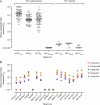Broad and potent neutralizing antibody responses elicited in natural HIV-2 infection
- PMID: 22031948
- PMCID: PMC3255805
- DOI: 10.1128/JVI.06155-11
Broad and potent neutralizing antibody responses elicited in natural HIV-2 infection
Abstract
Compared with human immunodeficiency virus type 1 (HIV-1), little is known about the susceptibility of HIV-2 to antibody neutralization. We characterized the potency and breadth of neutralizing antibody (NAb) responses in 64 subjects chronically infected with HIV-2 against three primary HIV-2 strains: HIV-2(7312A), HIV-2(ST), and HIV-2(UC1). Surprisingly, we observed in a single-cycle JC53bl-13/TZM-bl virus entry assay median reciprocal 50% inhibitory concentration (IC(50)) NAb titers of 1.7 × 10(5), 2.8 × 10(4), and 3.3 × 10(4), respectively. A subset of 5 patient plasma samples tested against a larger panel of 17 HIV-2 strains where the extracellular gp160 domain was substituted into the HIV-2(7312A) proviral backbone showed potent neutralization of all but 4 viruses. The specificity of antibody neutralization was confirmed using IgG purified from patient plasma, HIV-2 Envs cloned by single-genome amplification, viruses grown in human CD4(+) T cells and tested for neutralization sensitivity on human CD4(+) T target cells, and, as negative controls, env-minus viruses pseudotyped with HIV-1, vesicular stomatitis virus, or murine leukemia virus Env glycoproteins. Human monoclonal antibodies (MAbs) specific for HIV-2 V3 (6.10F), V4 (1.7A), CD4 binding site (CD4bs; 6.10B), CD4 induced (CD4i; 1.4H), and membrane-proximal external region (MPER; 4E10) epitopes potently neutralized the majority of 32 HIV-2 strains bearing Envs from 13 subjects. Patient antibodies competed with V3, V4, and CD4bs MAbs for binding to monomeric HIV-2 gp120 at titers that correlated significantly with NAb titers. HIV-2 MPER antibodies did not contribute to neutralization breadth or potency. These findings indicate that HIV-2 Env is highly immunogenic in natural infection, that high-titer broadly neutralizing antibodies are commonly elicited, and that unlike HIV-1, native HIV-2 Env trimers expose multiple broadly cross-reactive epitopes readily accessible to NAbs.
Figures








References
Publication types
MeSH terms
Substances
Grants and funding
LinkOut - more resources
Full Text Sources
Other Literature Sources
Medical
Research Materials

